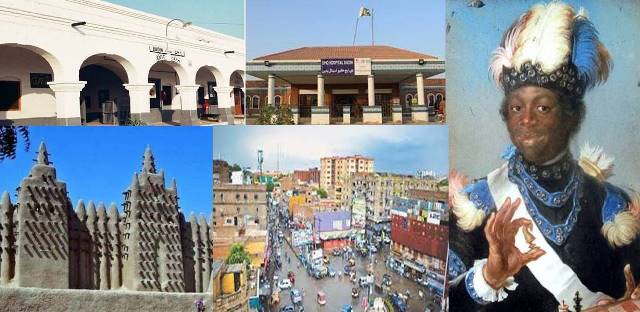Badin is 87th largest city of country and capital of District Badin. The city is situated on east of Indus River.
History of the district is more akin to the history of lower
Sindh. Original city was situated half mile away from the current city where
some reigns of old city are still seen now a days. Badin city was established
during 1750, later Madad Khan Pathan had attacked the city and ruined it
completely. Some of the coins of the Alexander the Great’s era have also been
found from the reigns of old city. Historians write the old name of Badin was
Sawalpur. It is listened that Badin was a caste of Mallahs (fishermen) and there
was a place with the name Badirh (بديڻ) which might had been
changed to Badin. Badirh mallah (fishermen) are still living in District Thatha. Doctor Nabi Bakhsh Baloch has revealed that name of Badin city has been
driven from Saint Shahabbadin who had settled 1.5 miles away from Badin city,
who is called yet place of Shah Badi in local pronunciation.
Juneja caste community was influential and strong in the area
during the Sama era. As per folk stories, Jam Adho Kehar had settled near to
Badin and Juneja community had murdered him, Later his wife Hothal Padmani
alongwith her son Jakhor and daughter Sukhar shifted to a village near to old
Badin. After growing up Jokhar, he alongwith his associates ambushed the Juneja
at Badin and destroyed whole city to avenge his father’s assassination.
Subsequently, this city was destroyed for the first due to a civil war. There
was also a river namely Rainr River crossing nearing to the city, since the
city had unique importance from agriculture point of view since the people resumed
resettlement of the city. During the Arghuns era, rifts were occurred during
between Mirza Saleh and Mirza Baqi Baig which resulted into the devastation of
Old Badin.
During the Kalhora governance, Madad Khan had attacked the
city and set ablaze the whole city, after which the old Badin could not be
resettled and New Badin was settled at the current location. As per Mirza
Kalich Baig, there was a graveyard near to old Badin, where 632 Hijri, 987
Hijri have been found written on stones of many graves. The current city was
established during year 1780 by Mirs.
Badin District is counted in one of the most important districts
of Sindh having coastal belts. The district is bounded with Tando Allahyar in
the North, Hyderabad District in the Northwest, Mirpurkhas and Tharparker
District in east, where as Kutch District of India in the south which
ultimately gives international border to the district and Districts Tando Muhammad Khan and Sajawal in the west. Prime Minister, Mr Zufiqar Ali Bhutto
had given the status of district to Badin in 1975 under Hyderabad Division .
There are five talukas in district Badin and these talukas
are further distributed in 68 union councils, while union councils are further
divided into 511 dehs. As per census held during 1998, population of the
district was 1,136,636 with 16% urban areas which has been increased to 1,804,516 as per the census conducted during
2017.
Main livelihood source of the district is
agriculture. The agricultural land of district is irrigated through Phuleli,
Guni Canal and Akram Canals of Kotri Barrage, moreover, Nasir Canal of Sukkur
Barrage also provides irrigation water to the district. As per census of 1998,
83.6% of total population relies on agriculture. Other main source of income of
people is cattle farming and fisheries. Main crop of the district is sugarcane
which is cultivated on 603000 hectors land of the district, while wheat,
cotton, rice, sunflower and vegetables are cultivated in the district. Fishing
is also a main source of District Badin and provides 10% of coastal fish to the
country. As per statistics of year 2002, Sindh province had produced 80659 tons
from fresh water, qhile Badin district had given 17.5% share to the province (14152
tons), which had made it Sindh’s 2nd highest district producing fish
from fresh water after District Thatta.
There are six sugar mills functioning in the
district therefore, the district is called as Sugar Mills’ State. Besides other
small factories of rice, flour and other small industries are installed in the
Badin district.
Crude oil is also found in district Badin, it
is perceived that 50% of total crude oil is found in Badin district therefore,
the district is also called Oil State of Pakistan. Coal has also been
discovered in the district which consists of 1110 Square kilometer and
estimated to have 1.358 Billion tons of coals.
There is no natural forest in district Badin
however, two forests namely Rari Forest and Boharki Forest 12000 hectors land
have been cultivated through fresh water of Indus River.
As per census of 1998, 24.633% of total
population is literate which increased to 27.52% during 2001. There is no
university in the district however, Sindh University has opened its campus at Badin
City and education of Business Administration, Commerce and Computer Science
subjects is being provided to the bachelor degree students of Badin district.
There is a district hospital in the Badin city,
three taluka hospitals 4 rural health centres, three dispensaries, forty six
basic health units, and approx. 100 other small health facilities in district
Badin. As per statistics of 2001, one doctors is available for 5428 people in
the district.
There is also a railway station at Badin which
connects Hyderabad through Matli town. Besides taluka headquarters are
connected with Badin through links roads.
There are two national assembly seats and five
Sindh assembly seat in Badin District. During general elections 2018, Mir
Ghulam Ali Talpur of PPP and Doctor Fahmida Mirza (wife of Doctor Zulifiqar
Mirza) of GDA became MNAs of NA 229 and NA 230 respectively. Dada Muhammad Halipota
of PPP (PS-70), Mir Allah Bakhsh Talpur of PPP (PS-71), Hasnain Ali
Mirza of GDA (PS-72), Taj Muhammad of PPP (PS-73) and Muhammad Ismail Rahoo of
PPP (PS-74) became of MPAs of Sindh Assembly during general elections 2018.
Atmosphere of Badin is polluted due to drainage
of waste water till Sea through Lift Bank Outfall Bank (LBOD), which deteriorate
the fresh water level of Badin as well as agricultural lands are affected due
to drainage water.













0 Comments
Please do not enter any spam link in the comments box